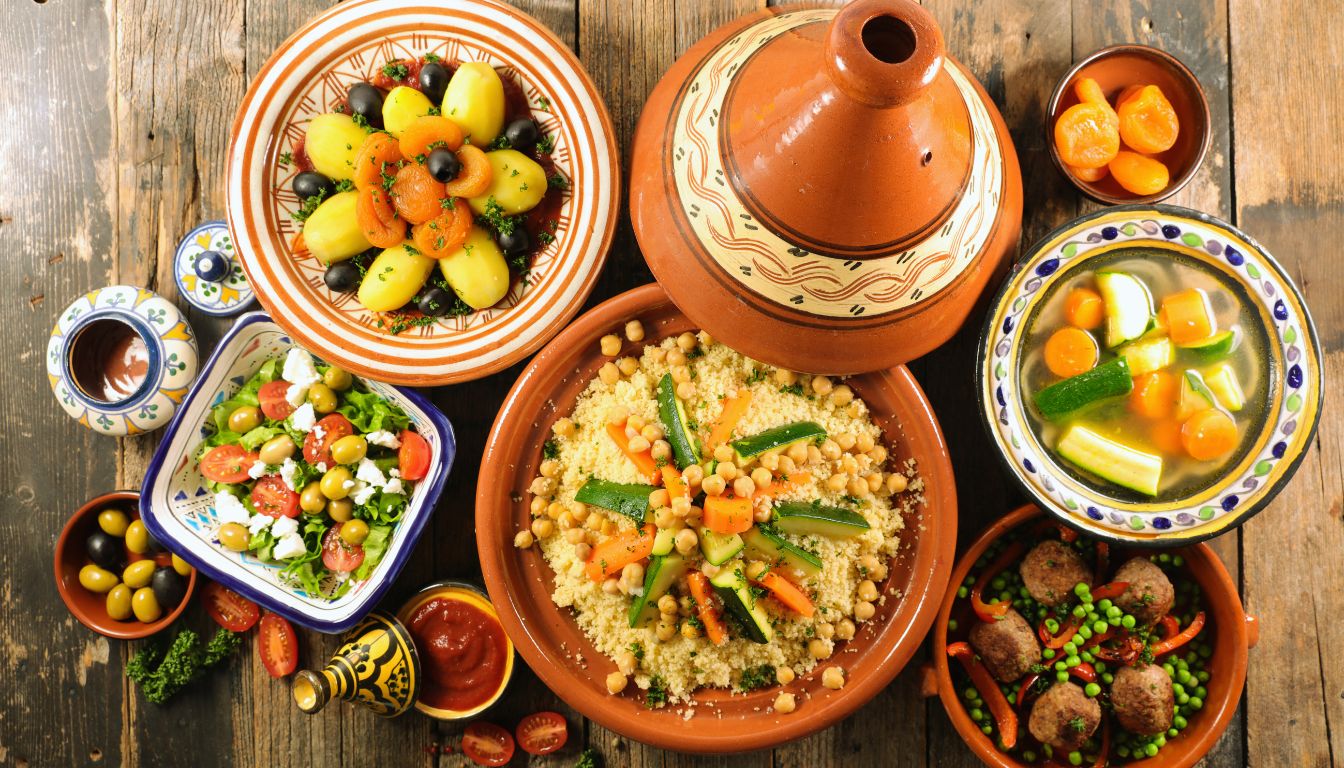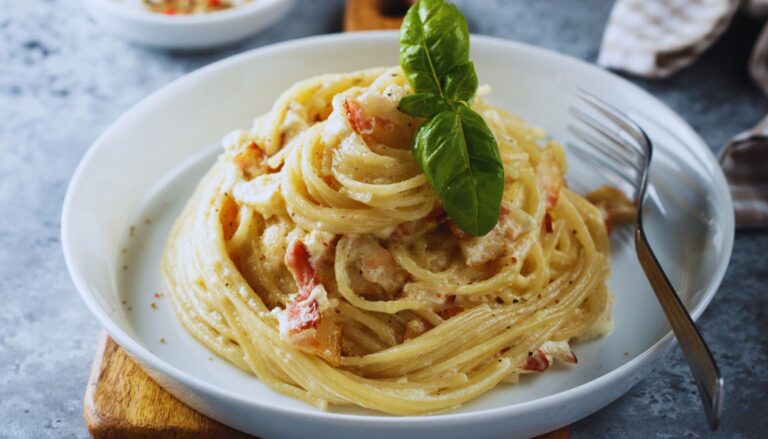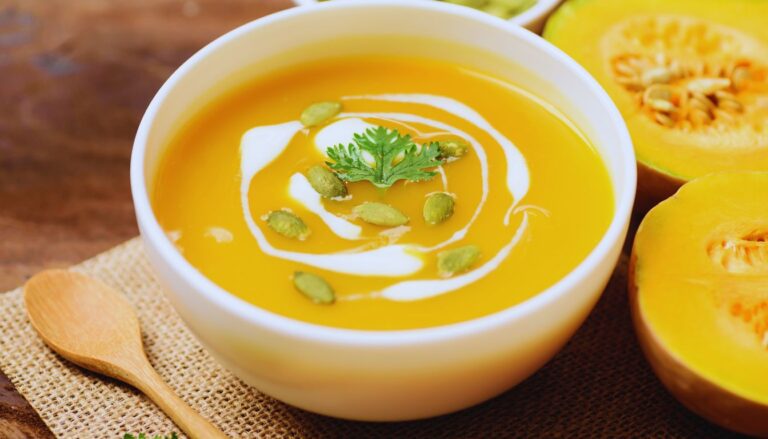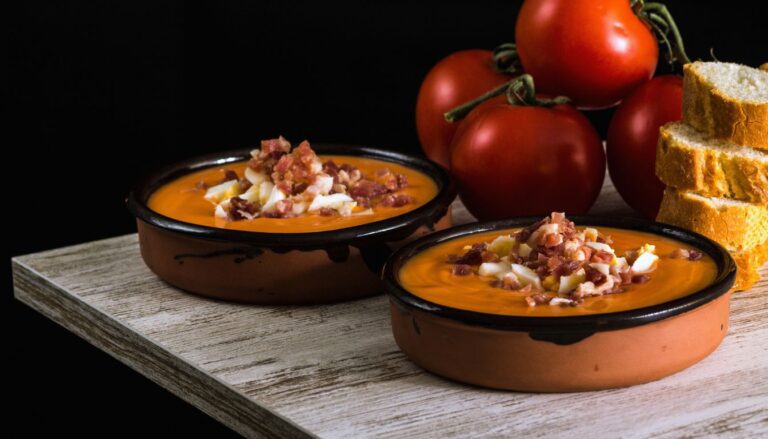Amazigh cuisine is a rich tapestry of flavors that has been woven over thousands of years in North Africa. This culinary tradition reflects the diverse landscapes of the region, from the Mediterranean coast to the Sahara Desert, and tells the story of a people deeply connected to their land and history.
Amazigh food is characterized by its use of fresh, locally sourced ingredients, aromatic spices, and time-honored cooking techniques. It forms the foundation of what many know as Moroccan, Algerian, or Tunisian cuisine, but with distinct regional variations and traditional dishes that are uniquely Amazigh.
In this culinary journey, we’ll explore the key ingredients, popular dishes, and cooking methods that make Amazigh cuisine a hidden treasure of North African gastronomy.
Table of Contents
The Heart of Amazigh Cooking: Staple Ingredients
At the core of Amazigh cuisine are several staple ingredients that form the basis of many traditional dishes:
- Grains: Wheat, barley, and semolina are used extensively in breads, couscous, and porridges.
- Legumes: Chickpeas, lentils, and fava beans provide protein and are used in soups, stews, and salads.
- Vegetables: Tomatoes, onions, carrots, and zucchini are common in many dishes, while pumpkin and turnips are popular in colder regions.
- Fruits: Dates, figs, and olives are not only eaten fresh but also used in cooking and preserving.
- Meats: Lamb and chicken are the most common, though beef and goat are also used. In coastal areas, fish is an important protein source.
- Dairy: Milk, butter, and yogurt from goats and sheep are used in both savory and sweet dishes.
- Oils: Olive oil and argan oil are essential for cooking and flavoring.
These ingredients reflect the agricultural heritage of the Amazigh people and their ability to make the most of their diverse environments.
Couscous: The King of Amazigh Dishes
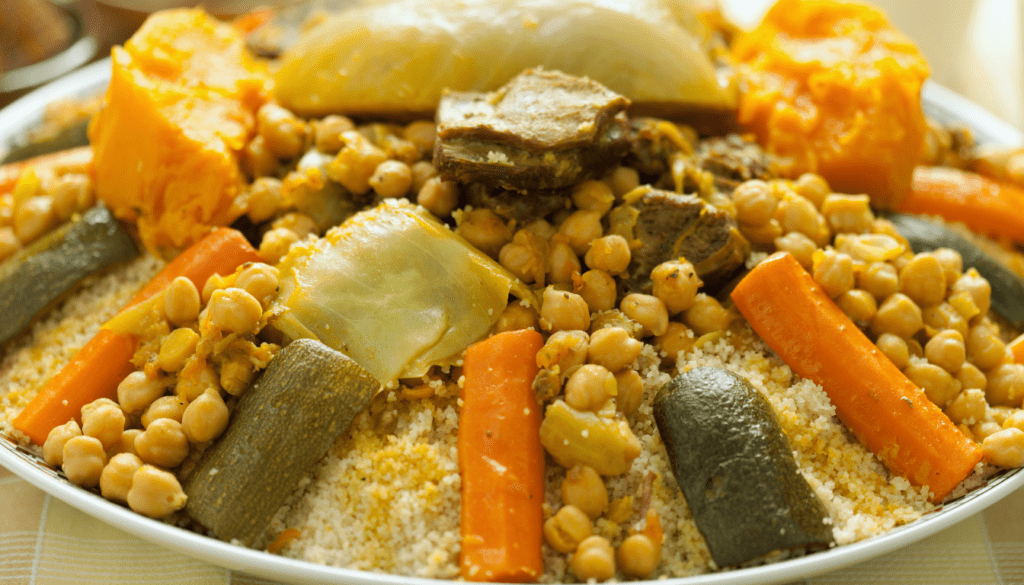
Couscous is perhaps the most famous dish in Amazigh cuisine, often considered the national dish in many North African countries. This versatile staple is made from tiny steamed semolina balls and is typically served with a flavorful stew of vegetables and meat.
Key aspects of couscous in Amazigh cuisine include:
- Preparation: Traditionally hand-rolled, though now often machine-made
- Cooking method: Steamed in a special pot called a couscoussier
- Variations: Can be sweet or savory, served with meat, vegetables, or even as a dessert
- Cultural significance: Often prepared for special occasions and communal gatherings
A typical Amazigh couscous dish might include:
- A base of steamed couscous
- A stew of lamb or chicken with vegetables like carrots, zucchini, and turnips
- Chickpeas for added protein
- A rich broth flavored with spices like cumin, coriander, and cinnamon
Couscous is not just a food but a symbol of Amazigh hospitality and community, often shared from a common dish in family gatherings.
Tagine: A Flavorful Journey in a Clay Pot
The tagine, both a cooking vessel and the dish prepared in it, is another cornerstone of Amazigh cuisine. This cone-shaped clay pot allows for slow cooking, resulting in tender meats and vegetables infused with complex flavors.
Common tagine variations include:
- Chicken with preserved lemons and olives
- Lamb with prunes and almonds
- Fish with chermoula (a herb and spice mixture)
- Vegetable tagine with seasonal produce
The slow-cooking process in a tagine allows flavors to meld together while keeping the ingredients moist. The dish is typically served directly from the tagine, creating a visually appealing presentation.
Tagines showcase the Amazigh talent for combining sweet and savory flavors, often incorporating dried fruits with meat and balancing spices to create a harmonious dish.
Bread Varieties in Amazigh Culture
Bread holds a special place in Amazigh cuisine, considered a staple in every meal. Various types of bread reflect regional differences and available ingredients:
- Aghrum: A round, flattish bread made from wheat or barley flour
- Batbout: Small, pocketlike bread cooked on a stovetop
- Msemen: Square-shaped, flaky bread often served with honey or jam
- Harcha: A semolina-based bread with a slightly gritty texture
Bread in Amazigh culture is more than just food; it’s considered sacred. Many Amazigh families still bake bread at home, often in traditional outdoor ovens. The aroma of freshly baked bread is a common and welcoming scent in Amazigh households.
Meat Dishes: From Mrouzia to Mechoui
Meat plays a significant role in Amazigh cuisine, particularly for special occasions and celebrations. Two standout meat dishes in Amazigh culinary tradition are Mrouzia and Mechoui.
Mrouzia:
- A sweet and savory tagine typically prepared for Eid al-Adha
- Features lamb cooked with honey, almonds, and raisins
- Spiced with ras el hanout, a complex spice blend
- The dish symbolizes abundance and celebration
Mechoui:
- A whole lamb slow-roasted over a fire pit or in an underground oven
- Often prepared for large gatherings or festivals
- Seasoned simply with salt, cumin, and sometimes saffron
- Represents Amazigh hospitality and communal dining
Other popular meat dishes include:
- Takila: A hearty stew of lamb or goat with vegetables
- Bouzelouf: A dish made from sheep’s head, considered a delicacy
- Kebabs: Skewered and grilled meat, often served with bread and salad
Vegetarian Delights in Amazigh Cuisine
While meat is important in Amazigh cuisine, there are also many delicious vegetarian dishes that showcase the bounty of local produce:
- Zaalouk: A smoky eggplant and tomato dip
- Taktouka: A salad of cooked peppers and tomatoes
- Loubia: A white bean stew flavored with tomatoes and cumin
- Bissara: A hearty fava bean soup popular in colder regions
These dishes often serve as side dishes (known as “kemia”) or can be combined to create a satisfying vegetarian meal. They highlight the Amazigh ability to create flavorful dishes from simple, plant-based ingredients.
Soups and Stews: Comfort Food with a North African Twist
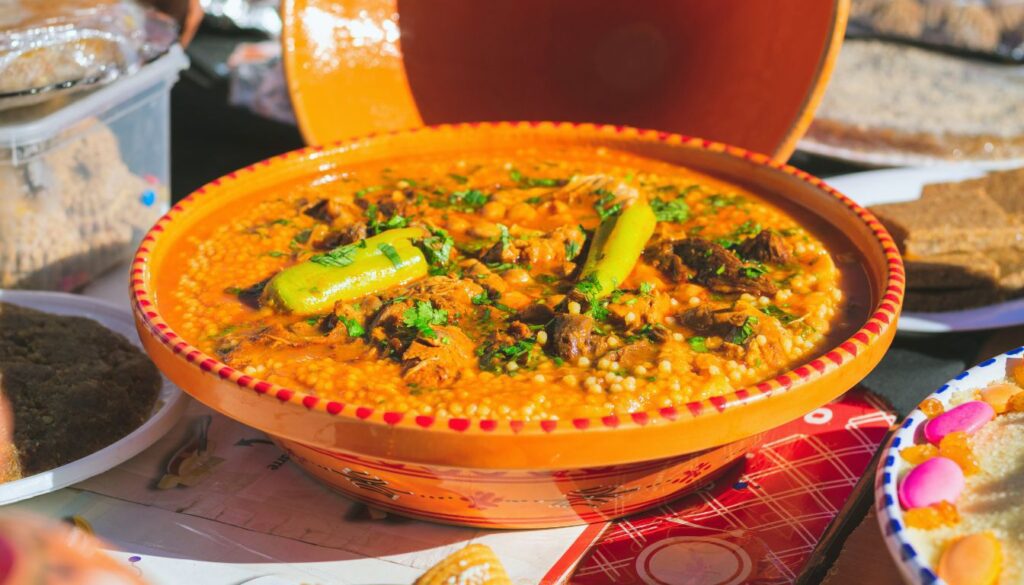
Soups and stews are an essential part of Amazigh cuisine, providing warmth and nourishment, especially during colder months. Some popular examples include:
- Harira: A tomato-based soup with lentils, chickpeas, and sometimes meat
- Chorba: A hearty soup made with lamb, vegetables, and chickpeas
- Berkoukes: A soup-like dish made with small hand-rolled pasta and vegetables
These dishes often combine grains or pasta with vegetables and sometimes meat, creating a complete meal in a single pot. They’re typically flavored with a blend of spices and fresh herbs, giving them a distinctly North African taste.
Sweet Treats: Amazigh Desserts and Pastries
Amazigh desserts often feature honey, nuts, and dried fruits. Some popular sweet treats include:
- Ghoriba: Shortbread cookies often made with almonds
- Sellou: A sweet flour-based confection eaten during Ramadan
- Sfenj: Deep-fried doughnuts often served with honey or sugar
- Meskouta: A simple cake flavored with orange flower water
Fruits, particularly dates and figs, also play a significant role in Amazigh desserts. They might be stuffed with almonds, dipped in honey, or simply served fresh as a sweet end to a meal.
Beverages: From Mint Tea to Date Milk
No exploration of Amazigh cuisine would be complete without mentioning traditional beverages:
- Mint Tea: Often called “Moroccan whiskey,” this sweet green tea infused with fresh mint is a symbol of hospitality
- Lben: A fermented milk drink similar to buttermilk
- Almond Milk: A sweet drink made from ground almonds, often served during Ramadan
- Date Milk: A nourishing drink made by blending dates with milk
These beverages not only quench thirst but also play important roles in social gatherings and religious observances.
Spices and Herbs: The Flavor Profile of Amazigh Cooking
Spices and herbs are crucial in Amazigh cuisine, adding depth and complexity to dishes. Common spices include:
- Cumin
- Coriander
- Cinnamon
- Saffron
- Turmeric
- Paprika
Fresh herbs like mint, parsley, and cilantro are also widely used. One of the most important spice blends is ras el hanout, a mixture that can contain up to 30 different spices and varies from region to region.
Modern Interpretations of Traditional Amazigh Dishes
While traditional Amazigh cuisine remains popular, modern chefs are finding new ways to interpret these classic flavors:
- Fusion dishes combining Amazigh ingredients with international cuisines
- Lighter versions of traditional dishes, using less oil and sugar
- Gourmet interpretations of street food favorites
- Vegetarian and vegan adaptations of meat-based dishes
These modern takes help introduce Amazigh flavors to a wider audience while preserving the essence of this rich culinary tradition.
Conclusion
Amazigh cuisine is a testament to the ingenuity and resourcefulness of North Africa’s indigenous people. From the humble couscous to elaborate meat dishes, from comforting soups to sweet pastries, this culinary tradition offers a diverse array of flavors and textures.
The use of local ingredients, slow cooking methods, and complex spice blends creates dishes that are not only delicious but also deeply connected to the land and culture of the Amazigh people. As interest in global cuisines continues to grow, Amazigh food offers a unique and flavorful experience for food lovers around the world.
Whether you’re savoring a steaming tagine, sipping on sweet mint tea, or breaking bread with an Amazigh family, each dish tells a story of tradition, hospitality, and the rich cultural heritage of North Africa. By exploring and appreciating Amazigh cuisine, we gain not just new flavors for our palates, but also a deeper understanding of a vibrant and enduring culture.
Discover the must-visit cultural destinations of Amazigh culture
UNESCO’s inscription of couscous traditions, an example of international cultural cooperation

